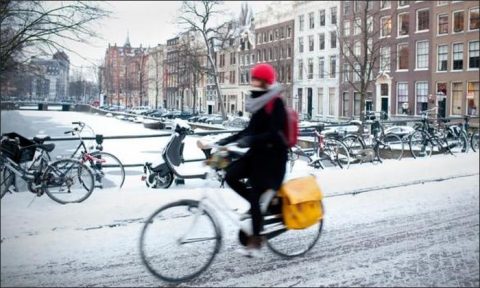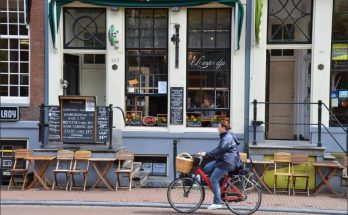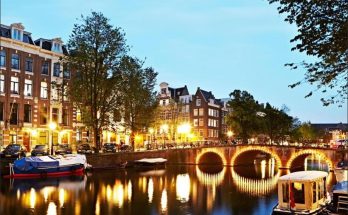As the official tourism board pushes to promote a cycle-friendly city, local commuters are getting frustrated with two-wheeled tourists.
According to Amsterdam’s tourism board, the canal-crossed Dutch port is one of the most cycle-friendly cities in the world, with a total of 600,000 bikes and 750,000 residents. But recently, locals have been less enthusiastic about the tourists that come to see Amsterdam on two wheels.
“The problem is that we Dutch are skilled cyclists. We’re like anarchists on bikes who know how to break the rules,” said graphic designer Rolf Hermsen, who is one of the many city residents who uses his bike to get around. “The tourists try to stick to the rules, but they can’t cycle properly. They can’t do things like keep cycling while looking for traffic behind them, so they end up wobbling all over the road and falling over.”
Anyone who’s cycled through Amsterdam will know that the Dutch show no mercy towards the amateur cyclist, often racing past them at high speed and cutting them off in between tram lines and bus stops. And tourists’ inability to keep up with the fast-paced cycle scene has prompted several residents to complain to the city council. Earlier this year, Dutch television aired a documentary on the rising tension between tourists and residents.
“There are people who say tourists need more instructions to ride bikes,” said Lennart Brans, one of the reporters that covered the story. “We’re seeing a growing trend in the number of Dutch people complaining about tourists. I think it’s because Amsterdam is a small city compared to other European capitals.”
Last year, Amsterdam saw a more than 5% increase in visitors – many of whom did rent bikes to get around. And for locals like Rolf, avoiding tourists wobbling on bikes is just one of the irritations that comes with the increased tourist volume.
Amsterdam also has a reputation as a “freedom” city for its lax approach to marijuana smoking and its vibrant red light district. Although the government has passed legislation preventing tourists from smoking dope in cafes starting in January 2013, its reputation as a party city is likely to continue. As a result, the city attracts thousands of “stag night” tourists each year, who are often responsible for noise pollution, garbage and vomit-covered streets.
The tourist board says that it’s these visitors, rather than the cycling ones, that cause the most friction with local residents. “The locals do not appreciate it when tourists clearly misbehave,” said Machteld Ligtvoeld from the Amsterdam Tourist Board. “We like to be a good host to all visitors, but all our guests need to be good guests as well.”
When it comes to cycling, Ligtvoeld said that Amsterdam residents are good at spotting “the tourist-on-wheels,” she said. “Tourists should, just like the locals, have lights on their bikes and follow general traffic instructions. Just because Amsterdam likes ‘freedom’ that does not mean there are no rules to be followed.”
Her solution to the clash between visitors and residents is to encourage tourists away from the crowded city centre into the less frenetic parks and cycleways of Amsterdam’s quieter suburbs. The board has published cycling maps of outer Amsterdam and the Dutch countryside especially for visitors, like this map on their website of South Amsterdam.
If you do choose to cycle in Amsterdam, the tourism board’s website helpfully explains where you can rent bikes and how to follow Amsterdam’s traffic rules.



